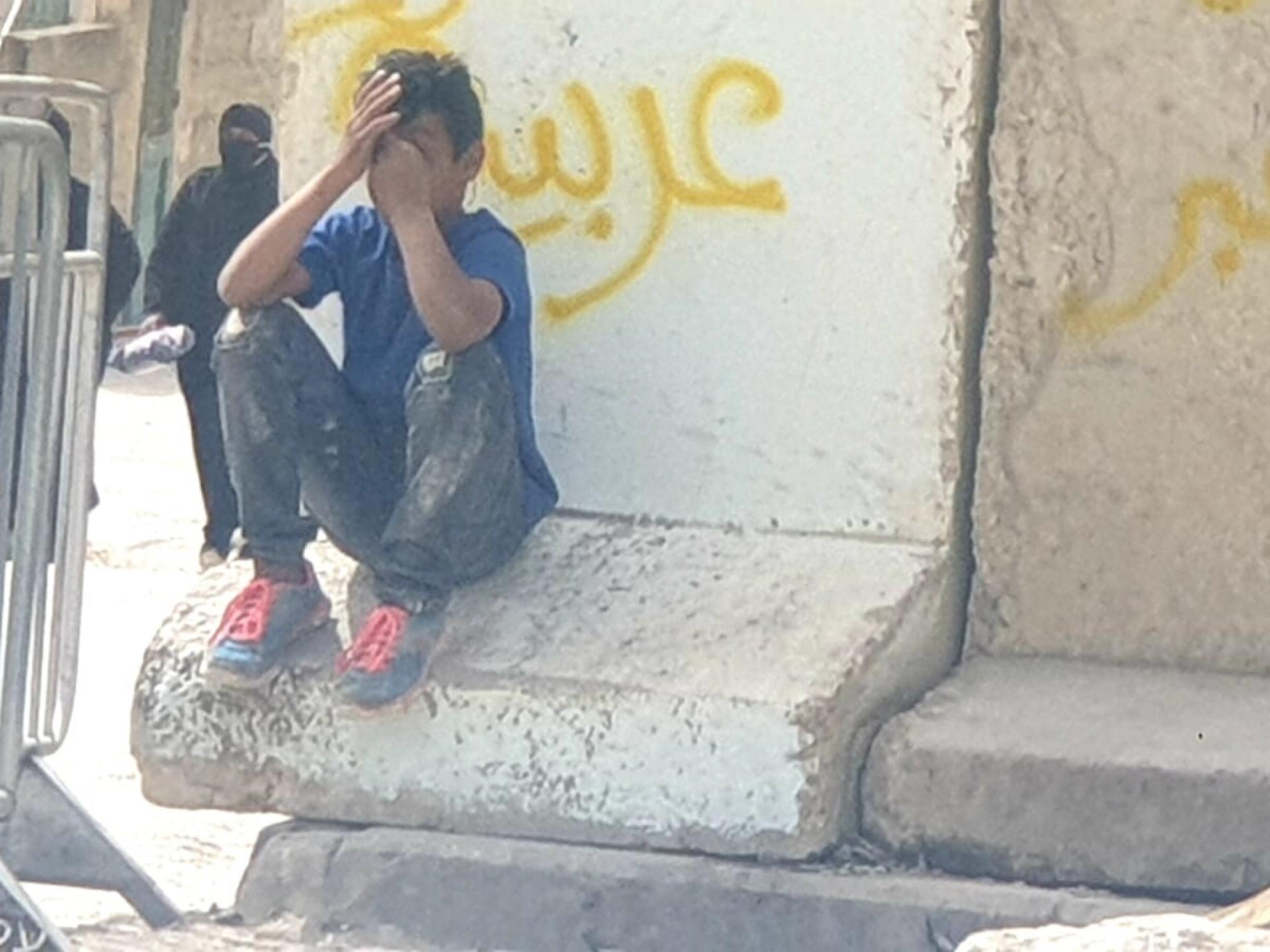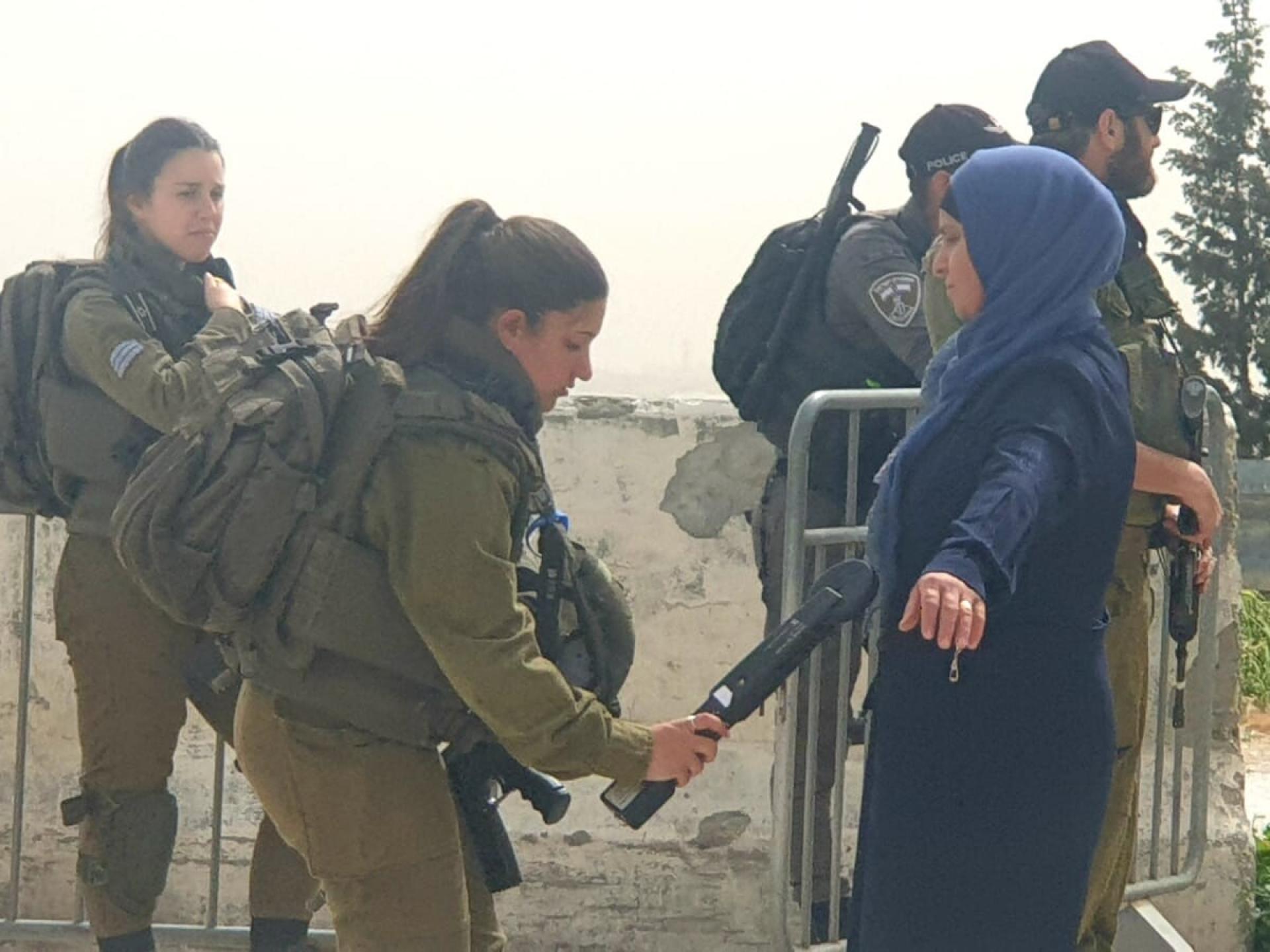Olive CP - 1st Friday of Ramadan
We were very apprehensive about the stricter restrictions on the access to the Temple Mount to worshippers during Ramadan. On the exposed hilltop a strong desert wind blew sand into our eyes. People had been going through the checkpoint to prayers since 4 AM, and would continue until the conclusion of prayers in the afternoon. It was fairly crowded, quiet, and very well organized, in two stages, with a convenient stand at the exit from the checkpoint to buy bus tickets to Damascus Gate (NIS 6). Security personnel of all kinds were everywhere. The behavior of the female soldiers who scanned the women with hand-held magnetometers was above reproach – calm, some even smiling. For the first time ever on a shift, I hugged one of the female soldiers!
10:00 AM. We weren’t allowed to approach the checkpoint with the car. The Border Police soldier at the foot of the road asked the checkpoint commander for permission to allow us to proceed on foot, as observers, and received it immediately. From this point on we were allowed complete access, including standing and photographing near the lines of men and women on the Palestinian side, and the soldiers inspections beyond the parking lot. We were pleasantly surprised. The rules were: free access to women and to children accompanying their parents (we also saw children older than 12, with no inspection of permits); men older than 50 didn’t need a permit; men aged 40-50 required a special Ramadan permit.
An orderly stand of a Jerusalem tour bus company was situated at the checkpoint entry/exit path to buy tickets in advance in order to alleviate lines to the buses. We saw adult men festively dressed and the elderly in traditional keffiyehs and gallabiyahs. We passed many women and children. Few younger men (in theory, only those older than 40 were permitted entry, but we saw some who looked younger). All seem to have undergone a long, exhausting journey to the checkpoint and wanted only to board the buses quickly. No one smiled.
After the exit to the Palestinian side a fence divided the path between those coming from Jerusalem and those leaving for Jerusalem. During the two hours we were there very few people were sent back to the Palestinian side. Many Border Police soldiers and male and female soldiers from the occupied territories military command inspected and provided security at three booths where ID’s and permits were checked using mobile phones. One Border Police soldier was stationed at the end of the empty plaza behind a line of concrete barriers. He held a weapon pointed at the area of the buses that transported people to the checkpoint. At every elevated location above the inspection booths we saw from a distance small groups of soldiers observing the area. The lines to the inspection booths were crowded, but not very long – two lines for women and children, and one for men. Everyone looked worried – after two years of drastic restrictions on permits, will the magical permit be cancelled in the middle of the long-awaited journey to the Old City?
After their permits were inspected the people passed one by one to be scanned, men and women separately. The female soldiers were nice – calm, occasionally smiling. This was the atmosphere throughout the two hours we were there. We wished a happy holiday to those coming through but didn’t initiate conversations. We had decided in advance that today we wouldn’t be able to hear stories of difficulties or solve humanitarian problems unconnected to the crossing. We did have a conversation with a biologist from Al Quds University who’d been checked and waited for his wife and two teenaged daughters. He was happy to have a family photo taken, he asked his wife and daughters to shake our hands and told us that connections with Israeli academics ended after the Oslo agreements. He hadn’t been to Jerusalem for three and a half years. We also asked two or three soldiers some questions. While the commanders ignored us demonstratively, some soldiers were cooperative. We left after expressing our admiration and I hugged one of the female soldiers.
We returned through the checkpoint structure itself. In the humanitarian lane women and children had only their parcels scanned on the conveyor belt and weren’t checked at a booth. Men in the other two lanes were checked at a booth only sporadically.
It appears that whoever is in charge of a particular checkpoint has a very great influence on how that checkpoint operates. We were in contact with Ronit who tried to enter the Palestinian side of the Qalandiya checkpoint but didn’t succeed. She told us that Tamar managed to enter in the face of drawn weapons. We saw Chana Barg’s report about violent resistance at the Bethlehem checkpoint. There was no hint of that at Zeitun.
God willing, the way Zeitun checkpoint is managed will serve as an inspiration for all the Ramadan prayers checkpoints next Friday – for those who believe in inspiration for good, and not just for attacks.


